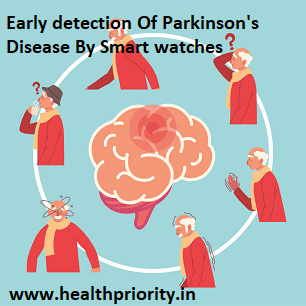Parkinson's disease is a complex neuro degenerative disorder that affects millions of people worldwide. Early diagnosis of Parkinson's is crucial for better disease management and improved patient outcomes. With advancements in wearable technology, specifically smartwatches, there is growing optimism about their potential role in detecting Parkinson's disease at its initial stages. Let us explore the possibilities of smartwatches as early diagnostic tools for Parkinson's disease.

How smart watches can help diagnose Parkinson's disease?
Understanding Parkinson's Disease

Parkinson's disease is characterized by the progressive degeneration of neurons in the brain, leading to a deficiency in dopamine, a neurotransmitter responsible for coordinating movement. Common symptoms include tremors, bradykinesia (slowness of movement), muscle stiffness, and balance problems. Diagnosing Parkinson's disease in its early stages can be challenging, as symptoms may be subtle and easily attributed to other factors.
The Role of Smartwatches
Smartwatches have evolved from being mere accessories to sophisticated health-monitoring devices. Equipped with various sensors, they can collect and analyze data related to a person's movements, heart rate, sleep patterns, and more. These features make them potential candidates for monitoring early signs of Parkinson's disease. Early diagnosis is crucial for timely intervention and effective disease management. In recent years, smartwatches have emerged as innovative tools that offer the potential to assist in the early detection of Parkinson's disease. These wearable devices equipped with advanced sensors and health-monitoring capabilities are revolutionizing the way we approach healthcare.
 |
| How smart watches can help diagnose Parkinson's disease? |
1. Gait Analysis/Continuous Monitoring of Movement:
Parkinson's disease often affects a person's gait, leading to changes in walking patterns. Smartwatches with built-in accelerometers and gyroscopes can track the user's movements and analyze their gait. By analyzing gait patterns, algorithms could detect abnormalities that may indicate early stages of Parkinson's disease.
One of the key features of smartwatches that makes them valuable for Parkinson's disease diagnosis is their ability to continuously monitor a person's movements. Built-in accelerometers and gyroscopes detect subtle changes in motion and gait patterns. Parkinson's disease often manifests with changes in walking and movements, and by analyzing these patterns over time, smartwatches can provide valuable insights to aid in early detection.
2. Tremor Detection:
Tremors are one of the hallmark symptoms of Parkinson's. Advanced smartwatches with high-precision sensors can monitor hand and arm movements continuously, providing valuable data on tremor frequency and intensity. This information, when analyzed over time, may help identify potential Parkinson's cases.
 |
| How smart watches can help diagnose Parkinson's disease? |
3. Sleep Patterns:
Parkinson's disease can disrupt sleep patterns, causing disturbances like REM sleep behavior disorder. Smartwatches equipped with sleep monitoring capabilities can track sleep quality, disturbances, and other sleep-related parameters. Detecting abnormal sleep patterns might signal the need for further evaluation for Parkinson's disease.
4. Voice Analysis:
Parkinson's disease can also affect a person's voice, causing changes in speech patterns and vocal quality. Some smartwatches can analyze voice recordings and identify subtle voice changes that may indicate early-stage Parkinson's disease.
5. Remote Patient Monitoring
Smartwatches enable remote patient monitoring, allowing individuals to collect and share relevant health data with their healthcare providers easily. This continuous stream of data provides doctors with a more comprehensive and up-to-date view of a patient's health, facilitating early diagnosis and personalized treatment plans.
 |
| How smart watches can help diagnose Parkinson's disease? |
6. Longitudinal Data Analysis
One of the significant advantages of smartwatches is their ability to collect longitudinal data. By tracking a person's health data over an extended period, smartwatches can help identify trends and changes that may indicate the onset of Parkinson's disease. Early detection through longitudinal data analysis can lead to earlier interventions and better management of the condition.
Challenges and Limitations
While the potential of smartwatches in early Parkinson's detection is promising, there are several challenges and limitations to consider:
- Data Accuracy: Smartwatch sensors may not always be as precise as medical-grade equipment used in clinical settings. The accuracy of the collected data is crucial for reliable detection.
- False Positives and Negatives: Algorithms used to interpret the collected data must strike a balance between sensitivity and specificity to minimize false positives and negatives.
- User Compliance: For smartwatches to be effective, users need to wear them consistently and follow data collection instructions. Low compliance rates could hinder data accuracy.
- Ethical Concerns: Wearable technology raises concerns about data privacy and how the information is used, stored, and shared. It's essential to address these ethical considerations.
 |
| How smart watches can help diagnose Parkinson's disease? |
Conclusion
While smartwatches show great promise as potential tools for early Parkinson's disease detection, they are not a replacement for professional medical diagnosis. The technology is still in its early stages, and more research is needed to validate its accuracy and reliability. Integrating smartwatches into healthcare systems, along with other clinical assessments, could enhance the early detection of Parkinson's disease and ultimately lead to improved patient outcomes. As technology continues to advance, wearable devices have the potential to revolutionize healthcare by facilitating early diagnosis and proactive management of various health conditions, including Parkinson's disease. However, it is essential to approach this technology with cautious optimism and maintain a balance between convenience and medical accuracy.

ConversionConversion EmoticonEmoticon